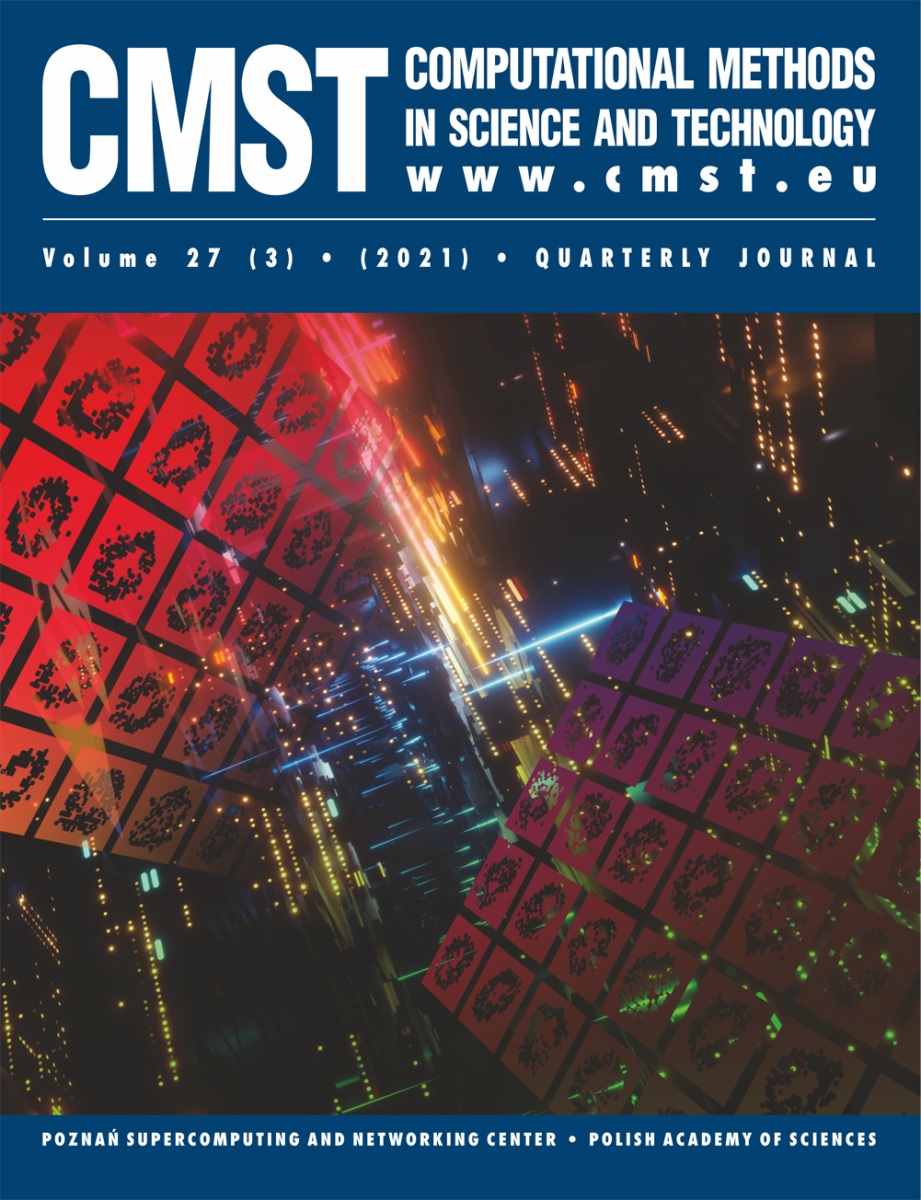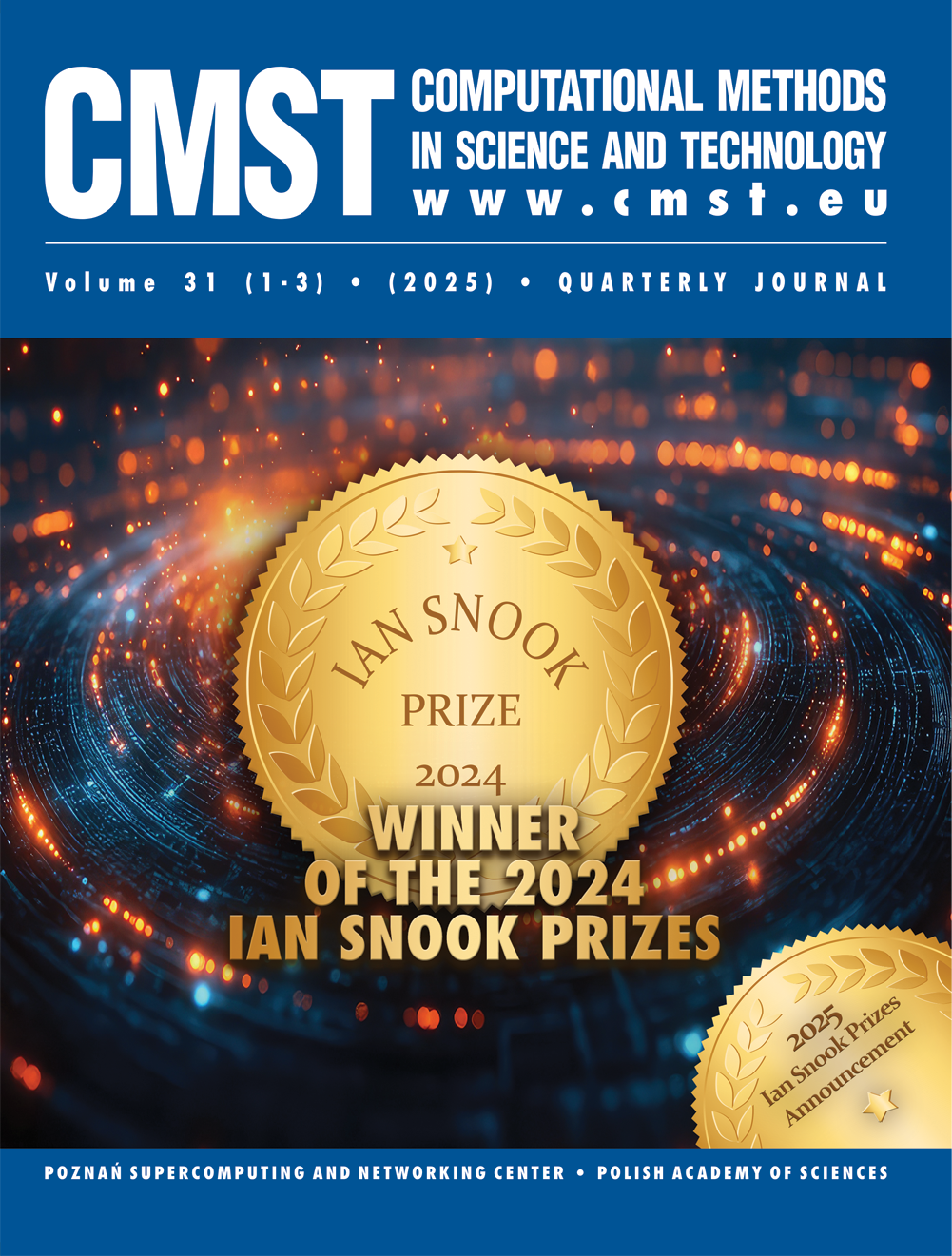The Simplest Viscous Flow
Hoover William G. *, Hoover Carol G.
Ruby Valley Research Institute
601 Highway Contract 60
Ruby Valley, Nevada 89833, USA
*E-mail: hooverwilliam@yahoo.com
Received:
Received: 6 June 2021; in final form: 9 July 2021; accepted: 9 July 2021; published online: 14 July 2021
DOI: 10.12921/cmst.2021.0000017
Abstract:
We illustrate an atomistic periodic two-dimensional stationary shear flow, u_x = ( x˙ ) = E˙y, using the simplest possible example, the periodic shear of just two particles! We use a short-ranged “realistic” pair potential, φ(r < 2) = (2 − r)^6 − 2(2 − r)^3. Many body simulations with it are capable of modelling the gas, liquid, and solid states of matter. A useful mechanics generating steady shear follows from a special (“Kewpie-Doll” ∼ “qp-Doll”) Hamiltonian based on the Hamiltonian coordinates {q} and momenta {p} : H(q, p) ≡ K(p) + Φ(q) + E˙ ), qp. Choosing qp →yp_x the resulting motion equations are consistent with steadily shearing periodic boundaries with a strain rate (du_x/dy) = E˙. The occasional x coordinate jumps associated with periodic boundary crossings in the y direction provide a Hamiltonian that is a piecewise-continuous function of time. A time-periodic isothermal steady state results when the Hamiltonian motion equations are augmented with a continuously variable thermostat generalizing Shuichi Nosé’s revolutionary ideas from 1984. The resulting distributions of coordinates and momenta are interesting multifractals, with surprising irreversible consequences from strictly time-reversible motion equations.
Key words:
fractals, Hamiltonian Molecular Dynamics, periodic boundaries, shear flow, statistical physics
References:
[1] T.C. Germann, K. Kadau, Trillion-Atom Molecular Dynamics Becomes a Reality, Journal of Modern Physics C 19, 1315–1319 (2008).
[2] W.T. Ashurst, Dense Fluid Shear Viscosity and Thermal Conductivity via Nonequilibrium Molecular Dynamics, University of California, Davis (1974).
[3] S. Nosé, A Unified Formulation of the Constant Temperature Molecular Dynamics Method, The Journal of Chemical Physics 81, 511–519 (1984).
[4] S. Nosé, Molecular Dynamics Method for Simulations in the Canonical Ensemble, Molecular Physics 52, 255–268 (1984).
[5] Wm.G. Hoover, Canonical Dynamics. Equilibrium Phase-Space Distributions, Physical Review A 31, 1695–1697 (1985).
[6] Wm.G. Hoover, Adiabatic Hamiltonian Deformation, Linear Response Theory, and Nonequilibrium Molecular Dynamics, [In:] Systems Far from Equilibrium, Ed. L. Garrido, Springer-Verlag, Berlin (1980).
[7] K.P. Travis, Wm.G. Hoover, C.G. Hoover, A.B. Hass, What is Liquid? [in two dimensions], Computational Methods in Science and Technology 27, 5–23 (2021).
[8] Wm.G. Hoover, C.G. Hoover, Comparison of Very Smooth Cell-Model Trajectories Using Five Symplectic and Two Runge-Kutta Integrators, Computational Methods in Science and Technology 21, 109–116 (2015).
[9] B.L. Holian, W.G. Hoover, H.A. Posch, Resolution of Loschmidt’s Paradox: The Origin of Irreversible Behavior in Reversible Atomistic Dynamics, Physical Review Letters 59, 10–13 (1987).
[10] W.G. Hoover, H.A. Posch, B.L. Holian, M.J. Gillan, M. Mareschal, C.M. Massobrio, Dissipative Irreversibility from Nosé’s Reversible Mechanics, Molecular Simulation 1, 79–86 (I987).
[11] J.C. Sprott, Some Simple Chaotic Flows, Physical Review E 50, R647 (1994).
[12] Wm.G. Hoover, Remark on “Some Simple Chaotic Flows”, Physical Review E 51, 759–760 (1995).
[13] Wm.G. Hoover, O. Kum, H.A. Posch, Time-Reversible Dissipative Ergodic Maps, Physical Review E 53, 2123–2129 (1996).
We illustrate an atomistic periodic two-dimensional stationary shear flow, u_x = ( x˙ ) = E˙y, using the simplest possible example, the periodic shear of just two particles! We use a short-ranged “realistic” pair potential, φ(r < 2) = (2 − r)^6 − 2(2 − r)^3. Many body simulations with it are capable of modelling the gas, liquid, and solid states of matter. A useful mechanics generating steady shear follows from a special (“Kewpie-Doll” ∼ “qp-Doll”) Hamiltonian based on the Hamiltonian coordinates {q} and momenta {p} : H(q, p) ≡ K(p) + Φ(q) + E˙ ), qp. Choosing qp →yp_x the resulting motion equations are consistent with steadily shearing periodic boundaries with a strain rate (du_x/dy) = E˙. The occasional x coordinate jumps associated with periodic boundary crossings in the y direction provide a Hamiltonian that is a piecewise-continuous function of time. A time-periodic isothermal steady state results when the Hamiltonian motion equations are augmented with a continuously variable thermostat generalizing Shuichi Nosé’s revolutionary ideas from 1984. The resulting distributions of coordinates and momenta are interesting multifractals, with surprising irreversible consequences from strictly time-reversible motion equations.
Key words:
fractals, Hamiltonian Molecular Dynamics, periodic boundaries, shear flow, statistical physics
References:
[1] T.C. Germann, K. Kadau, Trillion-Atom Molecular Dynamics Becomes a Reality, Journal of Modern Physics C 19, 1315–1319 (2008).
[2] W.T. Ashurst, Dense Fluid Shear Viscosity and Thermal Conductivity via Nonequilibrium Molecular Dynamics, University of California, Davis (1974).
[3] S. Nosé, A Unified Formulation of the Constant Temperature Molecular Dynamics Method, The Journal of Chemical Physics 81, 511–519 (1984).
[4] S. Nosé, Molecular Dynamics Method for Simulations in the Canonical Ensemble, Molecular Physics 52, 255–268 (1984).
[5] Wm.G. Hoover, Canonical Dynamics. Equilibrium Phase-Space Distributions, Physical Review A 31, 1695–1697 (1985).
[6] Wm.G. Hoover, Adiabatic Hamiltonian Deformation, Linear Response Theory, and Nonequilibrium Molecular Dynamics, [In:] Systems Far from Equilibrium, Ed. L. Garrido, Springer-Verlag, Berlin (1980).
[7] K.P. Travis, Wm.G. Hoover, C.G. Hoover, A.B. Hass, What is Liquid? [in two dimensions], Computational Methods in Science and Technology 27, 5–23 (2021).
[8] Wm.G. Hoover, C.G. Hoover, Comparison of Very Smooth Cell-Model Trajectories Using Five Symplectic and Two Runge-Kutta Integrators, Computational Methods in Science and Technology 21, 109–116 (2015).
[9] B.L. Holian, W.G. Hoover, H.A. Posch, Resolution of Loschmidt’s Paradox: The Origin of Irreversible Behavior in Reversible Atomistic Dynamics, Physical Review Letters 59, 10–13 (1987).
[10] W.G. Hoover, H.A. Posch, B.L. Holian, M.J. Gillan, M. Mareschal, C.M. Massobrio, Dissipative Irreversibility from Nosé’s Reversible Mechanics, Molecular Simulation 1, 79–86 (I987).
[11] J.C. Sprott, Some Simple Chaotic Flows, Physical Review E 50, R647 (1994).
[12] Wm.G. Hoover, Remark on “Some Simple Chaotic Flows”, Physical Review E 51, 759–760 (1995).
[13] Wm.G. Hoover, O. Kum, H.A. Posch, Time-Reversible Dissipative Ergodic Maps, Physical Review E 53, 2123–2129 (1996).

